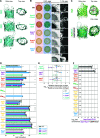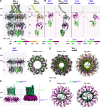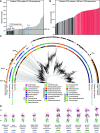Evidence for a Widespread Third System for Bacterial Polysaccharide Export across the Outer Membrane Comprising a Composite OPX/β-Barrel Translocon
- PMID: 35972145
- PMCID: PMC9601211
- DOI: 10.1128/mbio.02032-22
Evidence for a Widespread Third System for Bacterial Polysaccharide Export across the Outer Membrane Comprising a Composite OPX/β-Barrel Translocon
Abstract
In Gram-negative bacteria, secreted polysaccharides have multiple critical functions. In Wzx/Wzy- and ABC transporter-dependent pathways, an outer membrane (OM) polysaccharide export (OPX) type translocon exports the polysaccharide across the OM. The paradigm OPX protein Wza of Escherichia coli is an octamer in which the eight C-terminal domains form an α-helical OM pore and the eight copies of the three N-terminal domains (D1 to D3) form a periplasmic cavity. In synthase-dependent pathways, the OM translocon is a 16- to 18-stranded β-barrel protein. In Myxococcus xanthus, the secreted polysaccharide EPS (exopolysaccharide) is synthesized in a Wzx/Wzy-dependent pathway. Here, using experiments, phylogenomics, and computational structural biology, we identify and characterize EpsX as an OM 18-stranded β-barrel protein important for EPS synthesis and identify AlgE, a β-barrel translocon of a synthase-dependent pathway, as its closest structural homolog. We also find that EpsY, the OPX protein of the EPS pathway, consists only of the periplasmic D1 and D2 domains and completely lacks the domain for spanning the OM (herein termed a D1D2OPX protein). In vivo, EpsX and EpsY mutually stabilize each other and interact in in vivo pulldown experiments supporting their direct interaction. Based on these observations, we propose that EpsY and EpsX make up and represent a third type of translocon for polysaccharide export across the OM. Specifically, in this composite translocon, EpsX functions as the OM-spanning β-barrel translocon together with the periplasmic D1D2OPX protein EpsY. Based on computational genomics, similar composite systems are widespread in Gram-negative bacteria. IMPORTANCE Bacteria secrete a wide variety of polysaccharides that have critical functions in, e.g., fitness, surface colonization, and biofilm formation and in beneficial and pathogenic human-, animal-, and plant-microbe interactions. In Gram-negative bacteria, export of these chemically diverse polysaccharides across the outer membrane depends on two known translocons, i.e., an outer membrane OPX protein in Wzx/Wzy- and ABC transporter-dependent pathways and an outer membrane 16- to 18-stranded β-barrel protein in synthase-dependent pathways. Here, using a combination of experiments in Myxococcus xanthus, phylogenomics, and computational structural biology, we provide evidence supporting that a third type of translocon can export polysaccharides across the outer membrane. Specifically, in this translocon, an outer membrane-spanning β-barrel protein functions together with an entirely periplasmic OPX protein that completely lacks the domain for spanning the OM. Computational genomics support that similar composite systems are widespread in Gram-negative bacteria.
Keywords: Myxococcus xanthus; OM translocon; OPX proteins; Wzx/Wzy pathway; beta-barrel proteins; capsular polysaccharide; exopolysaccharide; export of polysaccharides; synthase-dependent pathway.
Conflict of interest statement
The authors declare no conflict of interest.
Figures





Similar articles
-
Bacterial Outer Membrane Polysaccharide Export (OPX) Proteins Occupy Three Structural Classes with Selective β-Barrel Porin Requirements for Polymer Secretion.Microbiol Spectr. 2022 Oct 26;10(5):e0129022. doi: 10.1128/spectrum.01290-22. Epub 2022 Oct 6. Microbiol Spectr. 2022. PMID: 36200915 Free PMC article.
-
Pivotal roles of the outer membrane polysaccharide export and polysaccharide copolymerase protein families in export of extracellular polysaccharides in gram-negative bacteria.Microbiol Mol Biol Rev. 2009 Mar;73(1):155-77. doi: 10.1128/MMBR.00024-08. Microbiol Mol Biol Rev. 2009. PMID: 19258536 Free PMC article. Review.
-
Structural and Functional Variation in Outer Membrane Polysaccharide Export (OPX) Proteins from the Two Major Capsule Assembly Pathways Present in Escherichia coli.J Bacteriol. 2019 Jun 21;201(14):e00213-19. doi: 10.1128/JB.00213-19. Print 2019 Jul 15. J Bacteriol. 2019. PMID: 31036729 Free PMC article.
-
Characterization of the Exopolysaccharide Biosynthesis Pathway in Myxococcus xanthus.J Bacteriol. 2020 Sep 8;202(19):e00335-20. doi: 10.1128/JB.00335-20. Print 2020 Sep 8. J Bacteriol. 2020. PMID: 32778557 Free PMC article.
-
ABC transporters and the export of capsular polysaccharides from gram-negative bacteria.Res Microbiol. 2001 Apr-May;152(3-4):357-64. doi: 10.1016/s0923-2508(01)01207-4. Res Microbiol. 2001. PMID: 11421283 Review.
Cited by
-
Molecular Dynamics of Outer Membrane-Embedded Polysaccharide Secretion Porins Reveals Closed Resting-State Surface Gates Targetable by Virtual Fragment Screening for Drug Hotspot Identification.ACS Omega. 2024 Mar 4;9(11):13217-13226. doi: 10.1021/acsomega.3c09970. eCollection 2024 Mar 19. ACS Omega. 2024. PMID: 38524450 Free PMC article.
-
Genetic Loci of Plant Pathogenic Dickeya solani IPO 2222 Expressed in Contact with Weed-Host Bittersweet Nightshade (Solanum dulcamara L.) Plants.Int J Mol Sci. 2024 Feb 28;25(5):2794. doi: 10.3390/ijms25052794. Int J Mol Sci. 2024. PMID: 38474041 Free PMC article.
-
Bacterial Outer Membrane Polysaccharide Export (OPX) Proteins Occupy Three Structural Classes with Selective β-Barrel Porin Requirements for Polymer Secretion.Microbiol Spectr. 2022 Oct 26;10(5):e0129022. doi: 10.1128/spectrum.01290-22. Epub 2022 Oct 6. Microbiol Spectr. 2022. PMID: 36200915 Free PMC article.
-
A deterministic, c-di-GMP-dependent program ensures the generation of phenotypically similar, symmetric daughter cells during cytokinesis.Nat Commun. 2024 Jul 17;15(1):6014. doi: 10.1038/s41467-024-50444-4. Nat Commun. 2024. PMID: 39019889 Free PMC article.
-
An exopolysaccharide pathway from a freshwater Sphingomonas isolate.J Bacteriol. 2024 Aug 22;206(8):e0016924. doi: 10.1128/jb.00169-24. Epub 2024 Jul 15. J Bacteriol. 2024. PMID: 39007563 Free PMC article.
References
-
- Morris G, Harding S. 2009. Polysaccharides, microbial, p 482–494. In Encyclopedia of microbiology. Elsevier. doi:10.1016/B978-012373944-5.00135-8. - DOI
Publication types
MeSH terms
Substances
LinkOut - more resources
Full Text Sources

